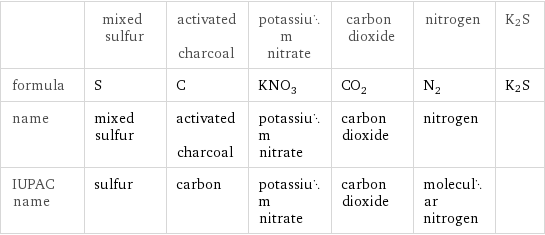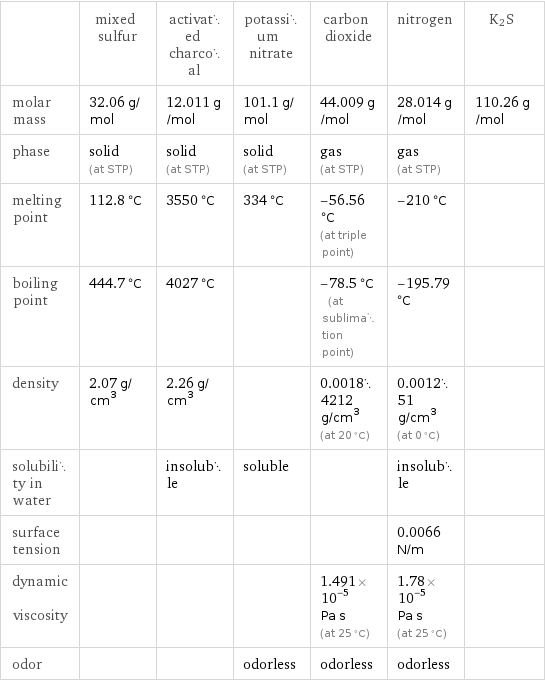Input interpretation

S (mixed sulfur) + C (activated charcoal) + KNO_3 (potassium nitrate) ⟶ CO_2 (carbon dioxide) + N_2 (nitrogen) + K2S
Balanced equation

Balance the chemical equation algebraically: S + C + KNO_3 ⟶ CO_2 + N_2 + K2S Add stoichiometric coefficients, c_i, to the reactants and products: c_1 S + c_2 C + c_3 KNO_3 ⟶ c_4 CO_2 + c_5 N_2 + c_6 K2S Set the number of atoms in the reactants equal to the number of atoms in the products for S, C, K, N and O: S: | c_1 = c_6 C: | c_2 = c_4 K: | c_3 = 2 c_6 N: | c_3 = 2 c_5 O: | 3 c_3 = 2 c_4 Since the coefficients are relative quantities and underdetermined, choose a coefficient to set arbitrarily. To keep the coefficients small, the arbitrary value is ordinarily one. For instance, set c_1 = 1 and solve the system of equations for the remaining coefficients: c_1 = 1 c_2 = 3 c_3 = 2 c_4 = 3 c_5 = 1 c_6 = 1 Substitute the coefficients into the chemical reaction to obtain the balanced equation: Answer: | | S + 3 C + 2 KNO_3 ⟶ 3 CO_2 + N_2 + K2S
Structures

+ + ⟶ + + K2S
Names

mixed sulfur + activated charcoal + potassium nitrate ⟶ carbon dioxide + nitrogen + K2S
Equilibrium constant
![Construct the equilibrium constant, K, expression for: S + C + KNO_3 ⟶ CO_2 + N_2 + K2S Plan: • Balance the chemical equation. • Determine the stoichiometric numbers. • Assemble the activity expression for each chemical species. • Use the activity expressions to build the equilibrium constant expression. Write the balanced chemical equation: S + 3 C + 2 KNO_3 ⟶ 3 CO_2 + N_2 + K2S Assign stoichiometric numbers, ν_i, using the stoichiometric coefficients, c_i, from the balanced chemical equation in the following manner: ν_i = -c_i for reactants and ν_i = c_i for products: chemical species | c_i | ν_i S | 1 | -1 C | 3 | -3 KNO_3 | 2 | -2 CO_2 | 3 | 3 N_2 | 1 | 1 K2S | 1 | 1 Assemble the activity expressions accounting for the state of matter and ν_i: chemical species | c_i | ν_i | activity expression S | 1 | -1 | ([S])^(-1) C | 3 | -3 | ([C])^(-3) KNO_3 | 2 | -2 | ([KNO3])^(-2) CO_2 | 3 | 3 | ([CO2])^3 N_2 | 1 | 1 | [N2] K2S | 1 | 1 | [K2S] The equilibrium constant symbol in the concentration basis is: K_c Mulitply the activity expressions to arrive at the K_c expression: Answer: | | K_c = ([S])^(-1) ([C])^(-3) ([KNO3])^(-2) ([CO2])^3 [N2] [K2S] = (([CO2])^3 [N2] [K2S])/([S] ([C])^3 ([KNO3])^2)](../image_source/79076fdfdaeb4a084fe05e4cfc69d9bb.png)
Construct the equilibrium constant, K, expression for: S + C + KNO_3 ⟶ CO_2 + N_2 + K2S Plan: • Balance the chemical equation. • Determine the stoichiometric numbers. • Assemble the activity expression for each chemical species. • Use the activity expressions to build the equilibrium constant expression. Write the balanced chemical equation: S + 3 C + 2 KNO_3 ⟶ 3 CO_2 + N_2 + K2S Assign stoichiometric numbers, ν_i, using the stoichiometric coefficients, c_i, from the balanced chemical equation in the following manner: ν_i = -c_i for reactants and ν_i = c_i for products: chemical species | c_i | ν_i S | 1 | -1 C | 3 | -3 KNO_3 | 2 | -2 CO_2 | 3 | 3 N_2 | 1 | 1 K2S | 1 | 1 Assemble the activity expressions accounting for the state of matter and ν_i: chemical species | c_i | ν_i | activity expression S | 1 | -1 | ([S])^(-1) C | 3 | -3 | ([C])^(-3) KNO_3 | 2 | -2 | ([KNO3])^(-2) CO_2 | 3 | 3 | ([CO2])^3 N_2 | 1 | 1 | [N2] K2S | 1 | 1 | [K2S] The equilibrium constant symbol in the concentration basis is: K_c Mulitply the activity expressions to arrive at the K_c expression: Answer: | | K_c = ([S])^(-1) ([C])^(-3) ([KNO3])^(-2) ([CO2])^3 [N2] [K2S] = (([CO2])^3 [N2] [K2S])/([S] ([C])^3 ([KNO3])^2)
Rate of reaction
![Construct the rate of reaction expression for: S + C + KNO_3 ⟶ CO_2 + N_2 + K2S Plan: • Balance the chemical equation. • Determine the stoichiometric numbers. • Assemble the rate term for each chemical species. • Write the rate of reaction expression. Write the balanced chemical equation: S + 3 C + 2 KNO_3 ⟶ 3 CO_2 + N_2 + K2S Assign stoichiometric numbers, ν_i, using the stoichiometric coefficients, c_i, from the balanced chemical equation in the following manner: ν_i = -c_i for reactants and ν_i = c_i for products: chemical species | c_i | ν_i S | 1 | -1 C | 3 | -3 KNO_3 | 2 | -2 CO_2 | 3 | 3 N_2 | 1 | 1 K2S | 1 | 1 The rate term for each chemical species, B_i, is 1/ν_i(Δ[B_i])/(Δt) where [B_i] is the amount concentration and t is time: chemical species | c_i | ν_i | rate term S | 1 | -1 | -(Δ[S])/(Δt) C | 3 | -3 | -1/3 (Δ[C])/(Δt) KNO_3 | 2 | -2 | -1/2 (Δ[KNO3])/(Δt) CO_2 | 3 | 3 | 1/3 (Δ[CO2])/(Δt) N_2 | 1 | 1 | (Δ[N2])/(Δt) K2S | 1 | 1 | (Δ[K2S])/(Δt) (for infinitesimal rate of change, replace Δ with d) Set the rate terms equal to each other to arrive at the rate expression: Answer: | | rate = -(Δ[S])/(Δt) = -1/3 (Δ[C])/(Δt) = -1/2 (Δ[KNO3])/(Δt) = 1/3 (Δ[CO2])/(Δt) = (Δ[N2])/(Δt) = (Δ[K2S])/(Δt) (assuming constant volume and no accumulation of intermediates or side products)](../image_source/f05cc8639ecd18137c8d582d235b09d5.png)
Construct the rate of reaction expression for: S + C + KNO_3 ⟶ CO_2 + N_2 + K2S Plan: • Balance the chemical equation. • Determine the stoichiometric numbers. • Assemble the rate term for each chemical species. • Write the rate of reaction expression. Write the balanced chemical equation: S + 3 C + 2 KNO_3 ⟶ 3 CO_2 + N_2 + K2S Assign stoichiometric numbers, ν_i, using the stoichiometric coefficients, c_i, from the balanced chemical equation in the following manner: ν_i = -c_i for reactants and ν_i = c_i for products: chemical species | c_i | ν_i S | 1 | -1 C | 3 | -3 KNO_3 | 2 | -2 CO_2 | 3 | 3 N_2 | 1 | 1 K2S | 1 | 1 The rate term for each chemical species, B_i, is 1/ν_i(Δ[B_i])/(Δt) where [B_i] is the amount concentration and t is time: chemical species | c_i | ν_i | rate term S | 1 | -1 | -(Δ[S])/(Δt) C | 3 | -3 | -1/3 (Δ[C])/(Δt) KNO_3 | 2 | -2 | -1/2 (Δ[KNO3])/(Δt) CO_2 | 3 | 3 | 1/3 (Δ[CO2])/(Δt) N_2 | 1 | 1 | (Δ[N2])/(Δt) K2S | 1 | 1 | (Δ[K2S])/(Δt) (for infinitesimal rate of change, replace Δ with d) Set the rate terms equal to each other to arrive at the rate expression: Answer: | | rate = -(Δ[S])/(Δt) = -1/3 (Δ[C])/(Δt) = -1/2 (Δ[KNO3])/(Δt) = 1/3 (Δ[CO2])/(Δt) = (Δ[N2])/(Δt) = (Δ[K2S])/(Δt) (assuming constant volume and no accumulation of intermediates or side products)
Chemical names and formulas

| mixed sulfur | activated charcoal | potassium nitrate | carbon dioxide | nitrogen | K2S formula | S | C | KNO_3 | CO_2 | N_2 | K2S name | mixed sulfur | activated charcoal | potassium nitrate | carbon dioxide | nitrogen | IUPAC name | sulfur | carbon | potassium nitrate | carbon dioxide | molecular nitrogen |
Substance properties

| mixed sulfur | activated charcoal | potassium nitrate | carbon dioxide | nitrogen | K2S molar mass | 32.06 g/mol | 12.011 g/mol | 101.1 g/mol | 44.009 g/mol | 28.014 g/mol | 110.26 g/mol phase | solid (at STP) | solid (at STP) | solid (at STP) | gas (at STP) | gas (at STP) | melting point | 112.8 °C | 3550 °C | 334 °C | -56.56 °C (at triple point) | -210 °C | boiling point | 444.7 °C | 4027 °C | | -78.5 °C (at sublimation point) | -195.79 °C | density | 2.07 g/cm^3 | 2.26 g/cm^3 | | 0.00184212 g/cm^3 (at 20 °C) | 0.001251 g/cm^3 (at 0 °C) | solubility in water | | insoluble | soluble | | insoluble | surface tension | | | | | 0.0066 N/m | dynamic viscosity | | | | 1.491×10^-5 Pa s (at 25 °C) | 1.78×10^-5 Pa s (at 25 °C) | odor | | | odorless | odorless | odorless |
Units
